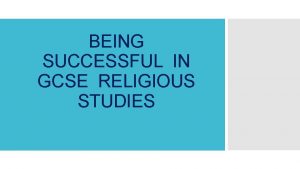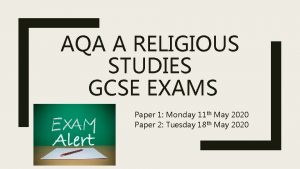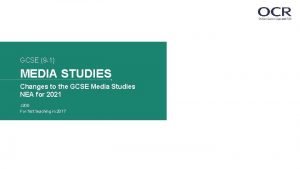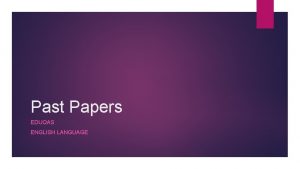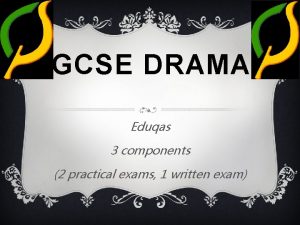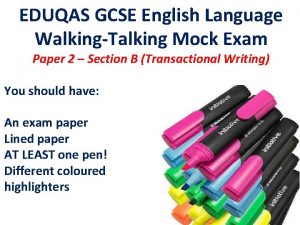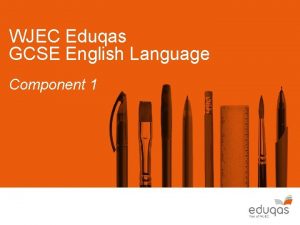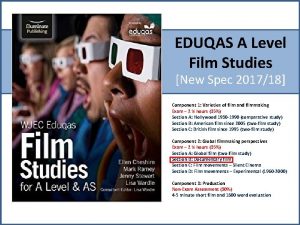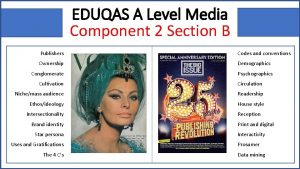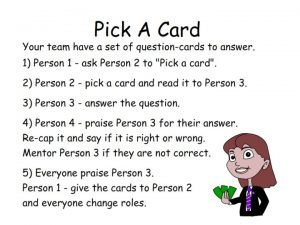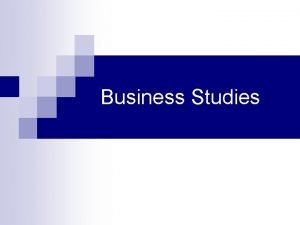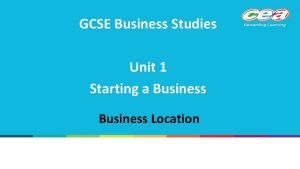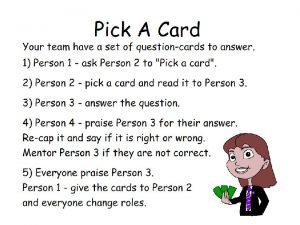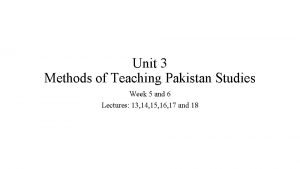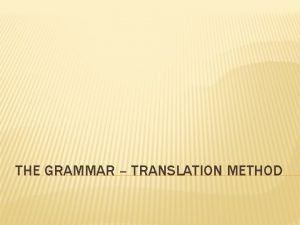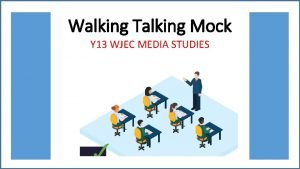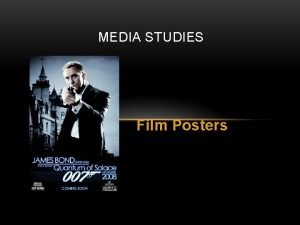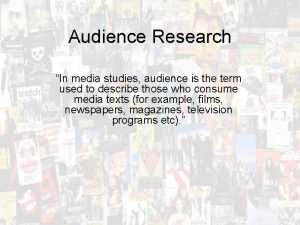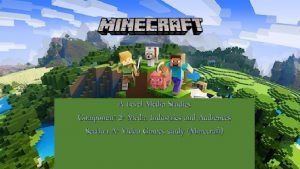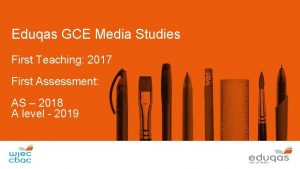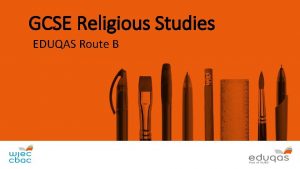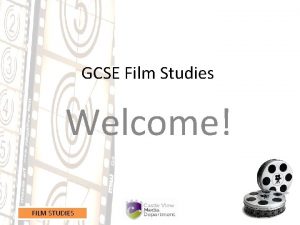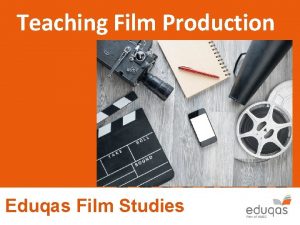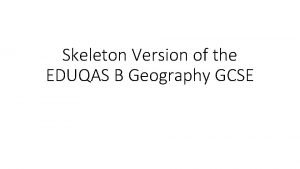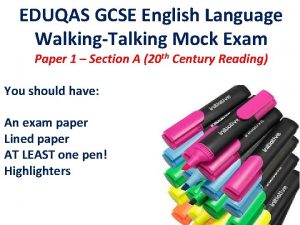Eduqas GCSE Media Studies First Teaching 2017 First































- Slides: 31

Eduqas GCSE Media Studies First Teaching: 2017 First Assessment: 2019

Overview/Aims This specification offers learners exciting opportunities to: • draw on their existing experience of the media and extend their appreciation and critical understanding • make connections: between different media forms and products, between media products and their contexts, and between theory and practical work • engage with a wide range of rich and stimulating media forms and products • develop media production skills, applying their knowledge and understanding of media language and representation to media forms and products.

Specification Highlights • Two distinct examination components – 70%. • Opportunity to engage in practical production work – 30%. • Exciting and inspiring set products, including a cross-media case study, offering some choice and flexibility. • Opportunities to explore a broad range of media forms and to study selected forms and products in greater depth. • Focus on contemporary platforms and products along with some historical products. • Excellent preparation for A level.

Overview of Examination Components Component 1: Exploring The Media (40%) Written examination: 1 hour 30 minutes Section A : Exploring Media Language and Representation The following forms are studied through examples set by WJEC Eduqas: • • Magazines Marketing (film posters) Newspapers Print advertisements Contexts are studied in relation to these forms. The examination includes the use of unseen resource material. Section B: Exploring Media Industries and Audiences The following forms are studied through examples set by WJEC Eduqas: • • Film Newspapers Radio Video games

Component 2: Understanding Media Forms and Products (30%) Written examination: 1 hour 30 minutes Focus on all areas of theoretical framework ( media language, representations, media industries and audiences) and contexts in relation to television and music. Section A: Television Section B: Music Detailed study of one television genre (either Crime Drama or Sitcom) Detailed study of music video and online media Products set by WJEC Eduqas: • One full episode • One 10 minute extract from a different product Products set by WJEC Eduqas: • Two contemporary music videos • • Online, social and participatory media surrounding the artists One music video from the past

Overview of Non-Exam Assessment Component 3: Media Production (30%) An individual media production for an intended audience in response to a choice of briefs set by WJEC, applying knowledge and understanding of media language and representation. Non-Exam Assessment

Assessment Objectives AO 1 Demonstrate knowledge and understanding of: • theoretical framework of media • contexts of media and their influence on media products and processes. AO 2 Analyse media products using theoretical framework of media, including in relation to their contexts, to make judgements and draw conclusions. AO 3 Create media products for an intended audience, by applying knowledge and understanding of theoretical framework of media to communicate meaning. Weighting of Assessment Objectives: AO 1 AO 2 AO 3 Total Component 1 20% - 40% Component 2 10% 20% - 30% Component 3 - - 30% 30% 40% 30% 100% Total

Theoretical Framework The theoretical framework for analysing and creating media provides learners with the tools to develop a critical understanding and appreciation of the media. The framework consists of four inter-related areas: • media language: how the media use forms, codes, conventions to communicate meanings • representation: how the media portray events, issues, individuals and social groups • media industries: how the media industries' processes of production, distribution and circulation affect media forms and platforms • audiences: how media forms target, reach and address audiences, how audiences interpret and respond to them, and how members of audiences become producers themselves.

Contexts of media Learners develop knowledge and understanding of relevant contexts of media and how these influence media products and processes. Historical Context • How the product reflects the time in which it was made. Social and Cultural Context • How the product reflects the society and culture in which it was made. • How the product is informed by cultural influences. Political Context • How the product reflects the political context in which it was made.

The theories and theoretical perspectives that apply to GCSE are: • theoretical perspectives on genre, including principles of repetition and variation; the dynamic nature of genre; hybridity and intertextuality • theories of narrative, including those derived from Propp • theoretical perspectives on representation, including processes of selection, construction and mediation • theoretical perspectives on gender and representation, including feminist approaches • theoretical perspectives on audiences, including active and passive audiences; audience response and audience interpretation • Blumler and Katz's Uses and Gratifications theory.

Component 1 • Foundation for analysing media language and representation. • Introduction to media industries and audiences. • Breadth of forms studied through a range of contemporary and historical products. • Develops knowledge and understanding of how relevant social, cultural, political and historical contexts influence media products. • Develops the ability to use relevant theories or theoretical perspectives and relevant subject-specific terminology.

Component 1: Exploring the Media forms Section Areas to be studied Contexts Newspapers In-depth study covering all areas of theoretical framework A and B Media language Representation Media industries Audiences √ Advertising and Marketing A Media language Representation √ Magazines A Media language Representation √ Radio B Media industries Audiences √ Video games B Media industries Audiences Film B Media industries

Section A • Foundation for analysing media language and representation in print products: • how the selection and combination of elements of media language influence and communicate meanings in media products • relevant representations of gender, ethnicity, age, issues and events in the media. • Learners develop their ability to use relevant theories or theoretical perspectives and relevant subject-specific terminology.

Section A: Forms and Products Magazine front covers Film posters (marketing) Newspaper front pages Print advertisements Pride The Man with the The Guardian Quality Street (November 2015) Golden Gun (1974) (4 September 2015) (1950 s) GQ Spectre (2015) The Sun This Girl Can (2016) (July 2016) (18 December 2015) All set products for section A will be provided via the WJEC Eduqas secure website. Learners should study at least two additional, contrasting products from each of the above forms to enable them to develop their analytical skills and explore a range of representations.

Section B • Introduction to media industries and audiences through the study of products from a range of industries and audiences. • Industry: ownership, funding, regulation, production, distribution and technology. • Audience: targeting and categorisation, consumption and use, and theoretical perspectives on audiences.

Section B: Forms and Products Newspapers Radio The Sun The Archers https: //www. thesun. co. uk/ one complete print edition of the newspaper and selected key pages from The Sun website • http: //www. bbc. co. uk/programmes/b 006 qpgr • one complete episode of The Archers and selected key pages from The Archers website Film Video Games Spectre, 12 (2015) Pokemon Go (2016) http: //www. 007. com/spectre/ • • media industries/ cross-media study only selected key pages from the Spectre section of the Official James Bond 007 website http: //www. pokemon. com/uk/ • • selected key pages from the Pokemon website extracts from the game may be considered to illustrate industry and audience issues • Centres choose the specific examples of the set products to study. • • Focus on set products as examples of the related media industries and audiences. • Analysis of textual features is not required in section B.

Assessment of Component 1: Section A Exploring Media Language and Representation (45 marks) • • • Two forms assessed Analysis of set products Analysis of unseen resource material Question 1: Media Language • Analysis of one of the set products. • Possible reference to relevant contexts. Section B Exploring Media Industries and Audiences (35 marks) • Knowledge and understanding of media industries and audiences in relation to any of the four forms studied Question 3 • Stepped question • Knowledge and understanding of media industries in relation to one form studied. Question 2: Context and Representation • Different media form from question one. Question 4 • Knowledge and understanding of context • Stepped question in relation to one set product. • Knowledge and understanding of • Comparison of unseen resource with a set audiences in relation to a different media product in the same media form. • Extended response question.

Component 2: Understanding Media Forms and Products • Deepens knowledge and understanding of media language, representation, media industries and audiences. • Explores topics through in-depth analysis of set products. • Develops knowledge and understanding of how relevant social, cultural, political and historical contexts influence media products. • Learners continue to develop the ability to use relevant theories or theoretical perspectives and relevant subject-specific terminology. Topics (both topics must be studied): • Television Genres: Crime Drama or Sitcom • Music cross-media study • Innovative and culturally relevant products set by WJEC, with both a contemporary and historical focus, including online and social media platforms.

Component 2: Television Set Products Topic Television Options 1. Crime Drama 2. Sitcom Set products Luther Series 1, Episode 1 (2010) , BBC Unbreakable Kimmy Schmidt Season 1, Episode 1 (2015), Netflix Centres select either Crime Drama or Sitcom option AND Ten minute extract from The Sweeney Series 1, Episode 1 (1975) , ITV AND Ten minute extract from Friends Season 1, Episode 1 (1994), NBC/ Channel 4 • Study all areas of theoretical framework in TV genre: media language, representations, financial importance to the television industry, popularity with television audiences. • Contemporary and older examples of the genre to highlight genre developments and to explore contexts.

Component 2: Music Video and Online Media Music Video Contemporary music videos Two music videos from the following options: Either Katy Perry, Roar (2013) or Taylor Swift, Bad Blood (2014) AND Either Pharrell Williams, Freedom (2015) or Bruno Mars, Uptown Funk (2014) Online Music videos from the 1980 s and early 1990 s Websites linked to the chosen contemporary music videos and artists One of the following music videos : Either http: //www. katyperry. com/ Or http: //taylorswift. com/ AND Either http: //www. brunomars. com/ Or http: //pharrellwilliams. com/ Either Duran, Rio (1982) or Michael Jackson, Black or White (1991) Social and participatory media in relation to an artist's website will be studied. Reference should be made at least to Facebook and Twitter

Section B • Detailed study of music through two contemporary music videos and artists’ online, social and participatory media. • Learners study one music video from the past to develop understanding of media language and of how representations reflect, and are influenced by, relevant contexts. • Learners also explore how the music industry uses conventional online forms such as websites as well as social and participatory media. • This will enable learners to explore a range of industry and audience issues.

Assessment of Component 2 Section A Television (30 marks) • Analysis of set products – an extract from the TV product will be set in the examination Question 1 • Analyse either media language or representation in relation to extract set. • (a) Analyse media products. • (b) Analyse and make judgements and draw conclusions. Reference to relevant contexts may be required. Question 2 • Knowledge and understanding of media industries, audiences or media contexts. Section B Music (music videos and online media) (30 marks) • Based on set products Question 3 • Make judgements and draw conclusions through analysis of set media products in terms of either media language or representation. • Reference to relevant contexts may be required. Question 4 • Knowledge and understanding of media industries, audiences or media contexts.

Component 3: Non-exam assessment Component 3 offers learners exciting opportunities to: • develop practical production skills • respond to a choice of set briefs in a range of forms • build on previous learning and apply their knowledge and understanding of media language and representation to a media production.

Component 3: Key Features • 30% of GCSE; internally assessed and externally moderated • Annual release of set briefs (March 1 st during the year prior to assessment). • Create individual media production work for an intended audience, applying knowledge and understanding of: • media language • Representations. • Assessment based largely on practical production work. • Statement of Aims to explain how the learner intends to respond to the brief and apply knowledge and understanding of theoretical framework.

Component 3: Set Briefs • Briefs will be released by Eduqas every year, requiring learners to create a production for a different intended audience • The following forms will always be set: • Television - Create a sequence from a new television programme or a website to promote a new television programme. • Advertising and Marketing: Music - Create a music video or a website to promote a new artist/band. • Advertising and Marketing: Film - Print-based marketing material for a new film. • Magazines - Create a new print or online magazine. • Eduqas will stipulate the genre, the intended target audience and other key requirements. • Learners will develop a response to their chosen brief and create a production aimed at the specified intended audience.

Key Requirements for Component 3 • Learners must submit: • A media production • A compulsory statement of aims for the production (approx. 250 words) • A completed cover sheet available on the Eduqas website • Supervision and monitoring: It is advised that learners spend up to twelve weeks developing and creating their production for Component 3. • teachers may advise on non-assessed research and planning • once production is underway feedback must be general • teachers monitor production process continually and sign at three key stages (research, planning, production) to authenticate the work.

Key Requirements for Component 3 • Individual production: the learner may use unassessed students and others: • to appear in their media products e. g. as actors or models or to operate equipment, e. g. lighting or sound recording equipment, under the direction of the assessed learner. • Use of original material: • learners must create original material for the production and a production that does not use original material cannot be awarded above band 2. • Equipment and resources for production work in Component 3: • software packages used in the creation of the production must be listed on the cover sheet with a brief explanation of how they have been used.

Assessment of Component 3 AO 3: Create media products for an intended audience, by applying knowledge and understanding of theoretical framework of media to communicate meaning Component 3 is internally assessed and externally moderated. The total number of marks available is 60: • 10 marks for the statement of aims. • 20 marks for creating a media product that meets the requirements of the set brief, including suitability for the specified form, genre and audience. • 30 marks for creating a media product which uses media language to communicate meanings and construct representations. Learners who do not submit a production will be awarded zero marks for the statement of aims.

Resources for Teachers Supporting teaching and learning We are producing a number of resources to support teaching and learning. These include: • Teacher’s guide • Course plan • Fact sheets on set products • Digital resources on specific topics e. g. News, Sitcom • Text book

Resources for Teachers Supporting teaching and learning Visit our website to access qualification information and download key documents. eduqas. co. uk/qualifications/media-studies Free Eduqas digital resources to support the teaching and learning of a broad range of subjects. resources. eduqas. co. uk

Any Questions? Contact our specialist Subject Officers and administrative team for your subject with any queries. jo. johnson@eduqas. co. uk sally. cunliffe@eduqas. co. uk @eduqas. co. uk
 Eduqas gcse media studies
Eduqas gcse media studies Eduqas religious studies past papers
Eduqas religious studies past papers Aqa religious studies a level past papers
Aqa religious studies a level past papers Wjec media studies past papers
Wjec media studies past papers Unit 1: media representations mark scheme
Unit 1: media representations mark scheme Eduqas gcse english language past papers
Eduqas gcse english language past papers Wjec gcse electronics
Wjec gcse electronics Drama eduqas gcse
Drama eduqas gcse Eduqas gcse english literature
Eduqas gcse english literature Eduqas gcse english language past papers
Eduqas gcse english language past papers Frances and jonathan eduqas
Frances and jonathan eduqas Eduqas film studies
Eduqas film studies Eduqas religious studies a level past papers
Eduqas religious studies a level past papers Business report example year 12
Business report example year 12 Vogue 1965 media studies
Vogue 1965 media studies Ocr gcse business past papers
Ocr gcse business past papers Human geography revision
Human geography revision Gcse business studies resources
Gcse business studies resources Ccea a level business studies
Ccea a level business studies Ocr j276/01
Ocr j276/01 Gcse business studies market research
Gcse business studies market research Business studies formulas gcse
Business studies formulas gcse Gcse business studies unit 1
Gcse business studies unit 1 Gcse business studies resources
Gcse business studies resources Paradigm shift from women studies to gender studies
Paradigm shift from women studies to gender studies Unit method of teaching
Unit method of teaching Advantages of grammar
Advantages of grammar Definition of microteaching
Definition of microteaching Pride magazine media studies
Pride magazine media studies Media studies posters
Media studies posters What is audience research in media
What is audience research in media Minecraft media studies
Minecraft media studies

